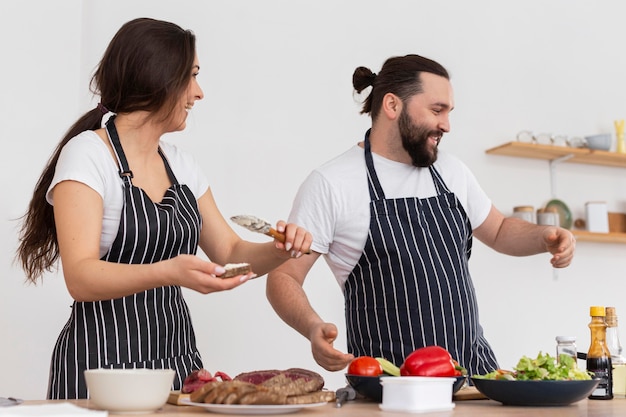(Part 1) The Basics of "Cook" in Spanish

Understanding the Verb "Cocinar"
"Cocinar" is a regular verb, which means it follows the usual conjugation patterns. That's good news for us because it makes it relatively straightforward to learn, especially if you're familiar with other regular Spanish verbs.Conjugating "Cocinar" in the Present Tense
Let's get practical. Here's how "cocinar" is conjugated in the present tense, which you'll use frequently in everyday conversations about cooking:| Yo (I) | Tú (You - informal) | ??l/Ella/Usted (He/She/You - formal) | Nosotros/Nosotras (We) | Vosotros/Vosotras (You - informal plural) | Ellos/Ellas/Ustedes (They/You - formal plural) | |
|---|---|---|---|---|---|---|
| Cocinar | Cocino | Cocinas | Cocina | Cocinamos | Cocináis | Cocinan |
A Quick Tip for Remembering
Remember that "o" ending for "yo" (I)? That's your key to unlocking the other conjugations. Just add an "s" to the "yo" form for "tú" (you), and an "n" for "nosotros" (we). The rest of the forms pretty much follow a pattern from there. Easy peasy, right?(Part 2) Beyond "Cocinar": Other Ways to Say "Cook"

"Preparar"
"Preparar" means "to prepare," and it's often used when you're describing the process of putting together a meal. Think of it as a more general term than "cocinar." For example, you might say:"Estoy preparando el desayuno." (I'm preparing breakfast.)"Hervir"
"Hervir" means "to boil" and is used specifically for cooking methods that involve boiling liquids. For example: "Estoy hirviendo los huevos." (I'm boiling the eggs.)"Fritar"
"Fritar" means "to fry," and it's used for cooking foods that are submerged in oil or fat. It's great for dishes like french fries, fried chicken, or tempura. For example:"Voy a freír las patatas." (I'm going to fry the potatoes.)"Asar"
"Asar" means "to roast," and it refers to cooking foods in an oven or over an open fire. It's a great method for cooking large cuts of meat, poultry, and vegetables. For example:"Voy a asar un pollo." (I'm going to roast a chicken.)(Part 3) Mastering the Art of Cooking in Spanish: Phrases and Expressions

1. "Tener hambre"
This means "to be hungry," and it's a great way to start a conversation about food. You can say: "Tengo mucha hambre." (I'm very hungry.)2. "Me encanta comer..."
This means "I love to eat..." and allows you to share your culinary preferences. For example:"Me encanta comer paella." (I love to eat paella.)3. "Estoy de dieta"
This means "I'm on a diet," and it's a useful phrase to use if you're trying to be mindful of what you eat. For example:"Estoy de dieta, así que no puedo comer mucho." (I'm on a diet, so I can't eat much.)4. "Tengo que cocinar..."
This means "I have to cook..." and can be used to express your culinary obligations. For example:"Tengo que cocinar la cena para mis amigos." (I have to cook dinner for my friends.)5. "Me gusta cocinar con..."
This means "I like to cook with..." and is a great way to share your cooking preferences and ingredients. For example:"Me gusta cocinar con especias." (I like to cook with spices.)(Part 4) Cooking Up a Conversation: Everyday Scenarios
Alright, so you've got the vocabulary down, but how do you actually use it in real-life conversations? Let's look at some common scenarios where you might need to talk about cooking in Spanish.1. At a Restaurant
When you're ordering food, you might need to ask questions about the dishes. For instance:"??Cómo se cocina este plato?" (How is this dish cooked?)2. At a Friend's House
If you're invited to a friend's house for dinner, you can compliment their cooking with:"??Qué rico está todo!" (Everything is so delicious!)3. At a Cooking Class
If you're taking a cooking class, you'll be able to follow the instructions with confidence. For example, the instructor might say:"Ahora vamos a freír las verduras." (Now we're going to fry the vegetables.)4. At the Supermarket
When you're shopping for ingredients, you can ask for help in Spanish. For instance:"??Dónde están las especias?" (Where are the spices?)(Part 5) Diving Deeper: Exploring Regional Differences
Spanish is a wonderfully diverse language, with variations in vocabulary and pronunciation depending on the region. This applies to cooking terms as well. While "cocinar" is the most common term across the Spanish-speaking world, there are some regional variations you might encounter."Cocinar" vs. "Guisar"
In some regions, like Spain, "guisar" is used more frequently than "cocinar." "Guisar" generally refers to simmering or stewing a dish, often with a specific sauce or broth. Think of it as a more specific method of "cocinar." So, while you might say "cocinar la paella" in Spain, you might also say "guisar la paella" in certain regions."Cocinar" vs. "Hacer"
In some Latin American countries, "hacer" is used more frequently than "cocinar" for certain types of food preparation. For example, you might say "hacer un pastel" (to bake a cake) in Mexico or Argentina. This is just a matter of regional preference, so don't be surprised if you hear it used this way.Regional Variations in cooking styles
Beyond vocabulary, there are also regional variations in cooking styles and techniques. For instance, Mexican cuisine is renowned for its use of spices and chili peppers, while Peruvian cuisine is known for its seafood dishes. Understanding these regional differences can deepen your appreciation for the diversity of Spanish cuisine.(Part 6) Unleashing Your Inner Chef: Tips for Cooking in Spanish
Now that you've got a solid understanding of the vocabulary and expressions, let's talk about how to actually use this knowledge in the kitchen. Here are some tips for cooking in Spanish that will help you feel confident in the kitchen and beyond.1. Start with simple recipes
Don't overwhelm yourself with complicated recipes at first. Start with simple dishes that use basic ingredients and techniques. This will help you build your confidence and familiarity with Spanish cooking vocabulary. For example, try a simple salad or a basic omelet. You'll be surprised how quickly you can build your skills and expand your repertoire.2. Use Online Resources
There are tons of online resources available that can help you find Spanish recipes, cooking shows, and even virtual cooking classes. These resources can expose you to different cooking styles, techniques, and vocabulary. You can find Spanish-language recipe websites, cookbooks, and even online cooking communities that can be great sources of inspiration.3. Find a Language Partner
One of the best ways to learn any language is to practice speaking it regularly. Find a language partner who's interested in cooking, and you can share recipes, ask questions, and learn from each other. This is a fantastic way to improve your conversational skills and learn about cooking from a different perspective.4. Don't Be Afraid to Make Mistakes
Everyone makes mistakes when they're learning a new language. Don't be afraid to experiment and try new things in the kitchen. Even if you mess up a recipe, you'll learn something new in the process. Remember, cooking is a journey of discovery, and you'll improve your Spanish skills along the way.(Part 7) Expanding Your Culinary Horizons: Exploring Spanish Cuisine
Learning how to say "cook" in Spanish is just the beginning of a delicious journey into the world of Spanish cuisine. Here are some famous Spanish dishes you might want to try:1. Paella
A vibrant and flavorful rice dish that originates from Valencia, Spain. It typically includes seafood, chicken, rabbit, and vegetables. Paella is a true symbol of Spanish cuisine and is often enjoyed in large gatherings.2. Tapas
Small, savory snacks that are often served in bars and restaurants throughout Spain. They come in a wide variety of flavors and ingredients. Tapas are a fantastic way to sample a variety of Spanish dishes and flavors. Some popular examples include patatas bravas (fried potatoes with spicy sauce), tortilla espa??ola (Spanish omelet), and gambas al ajillo (garlic shrimp).3. Gazpacho
A refreshing cold soup made from raw vegetables, typically tomatoes, cucumbers, peppers, and onions. It's perfect for hot summer days. Gazpacho is a popular dish throughout Spain, especially in the southern regions. It's a light and refreshing meal that's perfect for hot weather.4. Tortilla Espa??ola
A classic Spanish omelet made with eggs, potatoes, and onions. It can be served hot or cold. Tortilla espa??ola is a versatile dish that can be enjoyed for breakfast, lunch, or dinner. It's also a great option for picnics or packed lunches.5. Churros
Deep-fried pastries that are often served with chocolate sauce or sugar. They're a popular treat in Spain and Latin America. Churros are a delicious and indulgent dessert that's sure to satisfy your sweet tooth. They're often enjoyed with a cup of hot chocolate or coffee.(Part 8) The Joy of Cooking and Learning
I've always found that cooking is a great way to connect with other cultures. Learning how to say "cook" in Spanish, exploring different recipes, and sharing meals with friends and family has enriched my life in so many ways. It's opened up new culinary horizons, allowed me to appreciate the diversity of flavors and ingredients, and even helped me to connect with people from different backgrounds.So, embrace the challenge of learning how to say "cook" in Spanish, and let your culinary adventures begin. Who knows, you might even discover a new passion for cooking along the way. Bon appétit!FAQs
- What is the difference between "cocinar" and "guisar"?
- How do I pronounce "cocinar"?
- Is there a difference between "cocinar" and "hacer" for certain dishes?
- What are some common cooking verbs in Spanish?
- What are some good resources for learning more about Spanish cuisine?
"Cocinar" is the general term for "cook," while "guisar" is a more specific method that involves simmering or stewing a dish, often with a specific sauce or broth. Think of it as a slower, more flavorful cooking technique. "Guisar" is often used for dishes like stews, braises, and casseroles, which require a longer cooking time to develop rich flavors.
The pronunciation of "cocinar" is similar to "co-see-nar." The "c" at the beginning is pronounced like the "s" in "sin." The "i" is pronounced like the "ee" in "see." And the "ar" at the end is pronounced like the "ar" in "car."
In some Latin American countries, "hacer" is used more frequently than "cocinar" for certain types of food preparation, like baking cakes or making bread. This can vary depending on the region and the specific dish. You'll hear both "hacer un pastel" and "cocinar un pastel" depending on where you are.
Besides "cocinar," other common cooking verbs include "freír" (to fry), "asar" (to roast), "hervir" (to boil), "hornear" (to bake), and "preparar" (to prepare). These verbs will help you describe the various cooking methods you use in the kitchen.
There are many great resources available, including online recipe websites, cooking shows, cookbooks, and even virtual cooking classes. You can also explore Spanish food blogs and online communities dedicated to Spanish cuisine. You can find a wealth of information and inspiration online.
Everyone is watching

Corn on the Cob: The Ultimate Guide to Perfectly Cooked Ears
Healthy MealsAh, corn on the cob. Just the name evokes images of sunny days, barbecues, and that sweet, juicy flavour that ...

Perfect Pork Roast Oven Cooking Time: A Guide to Delicious Results
Healthy MealsThere's something truly satisfying about a perfectly roasted pork. The aroma alone is enough to make your mout...

Ham Cooking Time: How Long to Bake, Smoke, or Boil a Delicious Ham
Healthy MealsAh, ham. It's a classic, isn't it? A real crowd-pleaser, especially around holidays. And when done right, it'...

Scallops: The Ultimate Guide to Perfect Cooking
Healthy MealsAh, scallops. Those delicate, sweet, and utterly delicious morsels of the sea. They hold a special place in my...

Spaghetti Squash: The Ultimate Guide to Cooking and Serving
Healthy MealsRemember that time you saw spaghetti squash at the supermarket, looking all bumpy and strange, and thought, "W...
